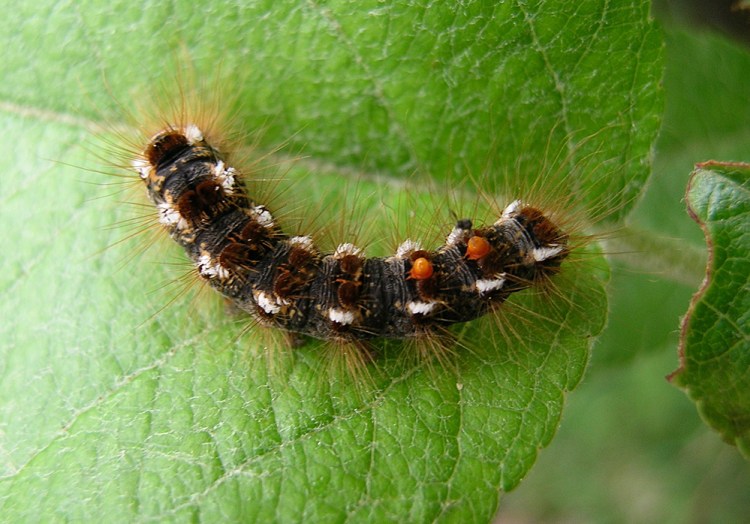HALLOWELL — A city committee is raising awareness for potentially dangerous caterpillars that state conservation officials say are increasing in population and increasingly gaining a foothold in central Maine.
The 1.5-inch browntail moth caterpillars have tiny hairs that irritate skin similar to poison ivy and cause respiratory issues, according to the Maine Department of Agriculture Conservation and Forestry. They are dark in color with short brown hairs and sport two distinctive red spots. At full maturity, the moths are white with a single tuft of brown hair on the abdomen.
The caterpillars can stymie tree and shrub growth by feeding on leaves. Their bright web silken webs are about 2 to 5 inches long and tightly woven around one or a few leaves. The conservation department said webs should be clipped by mid-April and then destroyed by soaking in soapy water or burning. If caterpillars are found on structures, surfaces should be hosed down and any residue vacuumed up.

A Browntail moth nest. Photo courtesy of Maine Department of Conservation, Agriculture and Forestry
The Portland Press Herald reported in June 2018 that browntail moths are found at varying population densities over more than 6,500 square miles in Maine, most highly concentrated in Brunswick, Bath and Topsham. But the high-risk exposure area has expanded as far west as Turner, south to Falmouth and east to Jefferson, according to state forestry officials.
Conservation department forest entomologist Allison Kanoti said she did not have “rock solid” evidence as to why there has been a recent boom in the moths’ density. She said warmer weather in the late summer, which gives the caterpillars more time to feed and become strong, and dry springs, which decreases growth of fungal infections that kill the caterpillars, could be the onus for the high growth cycle lately.
Kanoti said the browntail moth has been common in Maine since 1906, citing department documents that mentioned midcoast residents getting used to the “browntail itch.” More recently, she said moth populations have been denser near the coast, but inland areas, like Augusta, Jay, and Lewiston, have also seen booms.
“It certainly had footholds in the Augusta area,” she said. “It’s just the populations are increasing now (and), in recent memory, people haven’t felt the impact outside of the coast area.”
The chairwoman of the Hallowell’s conservation commission, Rosemary Presnar, said commission members have noticed nests on trees this year along Central Street and Orchard Lane. She expects a significant increase in caterpillars and related issues if no preventative measures are taken.
“We have noticed enough nests high in oaks and on ornamental fruit trees to be concerned,” she said Friday. “The nests are at the tips of tree branches and can be mistaken for just a dried leaf (and) even small nests the size of one oak leaf can house hundreds of caterpillars.”
Presnar said the commission is working with the city to raise awareness about the caterpillars. She said brochures are available at the City Hall and the commission is working with the Hubbard Free Library to provide poles to help cut out the nests on high tree limbs.
“The key is making city residents aware of the problems around browntail moths and what we can do to minimize impact,” she said. “Just as we have become aware and practice precautions around ticks and their prevalence over the past several years, we now have to raise the concern and awareness about the browntail moth.”
Hallowell City Manager Nate Rudy said the city has posted information videos on its Facebook page and plans to speak to Public Works about the possibility of removing nests from trees on city property.
When asked if the hospital has seen any cases related to browntail moth exposure, Maine General Medical Center representative Joy McKenna said she could not track down any information.
Other Maine municipalities are stepped up anti-caterpillar efforts this year.
Falmouth officials are urging residents to clip webs ahead of roadside pesticide spraying in May. The Forecaster reported this month that the town is spending $41,000 to spray an additional eight miles this year, an $11,000 increase over last year’s spending.
Sam Shepherd — 621-5666
sshepherd@centralmaine.com
Twitter: @SamShepME
Send questions/comments to the editors.




Success. Please wait for the page to reload. If the page does not reload within 5 seconds, please refresh the page.
Enter your email and password to access comments.
Hi, to comment on stories you must . This profile is in addition to your subscription and website login.
Already have a commenting profile? .
Invalid username/password.
Please check your email to confirm and complete your registration.
Only subscribers are eligible to post comments. Please subscribe or login first for digital access. Here’s why.
Use the form below to reset your password. When you've submitted your account email, we will send an email with a reset code.